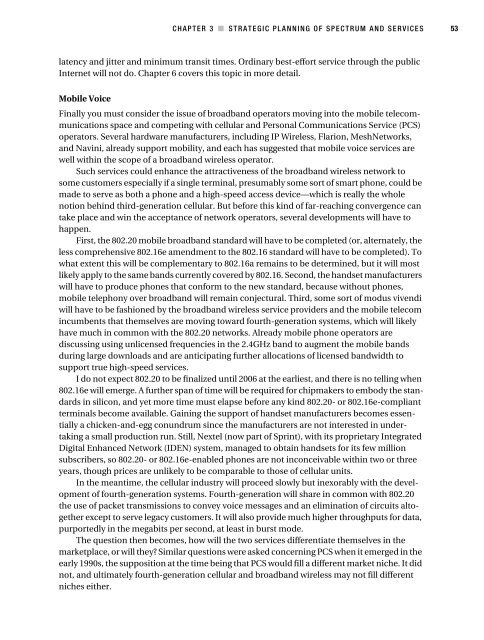WiMax Operator's Manual
WiMax Operator's Manual
WiMax Operator's Manual
Create successful ePaper yourself
Turn your PDF publications into a flip-book with our unique Google optimized e-Paper software.
CHAPTER 3 ■ STRATEGIC PLANNING OF SPECTRUM AND SERVICES 53<br />
latency and jitter and minimum transit times. Ordinary best-effort service through the public<br />
Internet will not do. Chapter 6 covers this topic in more detail.<br />
Mobile Voice<br />
Finally you must consider the issue of broadband operators moving into the mobile telecommunications<br />
space and competing with cellular and Personal Communications Service (PCS)<br />
operators. Several hardware manufacturers, including IP Wireless, Flarion, MeshNetworks,<br />
and Navini, already support mobility, and each has suggested that mobile voice services are<br />
well within the scope of a broadband wireless operator.<br />
Such services could enhance the attractiveness of the broadband wireless network to<br />
some customers especially if a single terminal, presumably some sort of smart phone, could be<br />
made to serve as both a phone and a high-speed access device—which is really the whole<br />
notion behind third-generation cellular. But before this kind of far-reaching convergence can<br />
take place and win the acceptance of network operators, several developments will have to<br />
happen.<br />
First, the 802.20 mobile broadband standard will have to be completed (or, alternately, the<br />
less comprehensive 802.16e amendment to the 802.16 standard will have to be completed). To<br />
what extent this will be complementary to 802.16a remains to be determined, but it will most<br />
likely apply to the same bands currently covered by 802.16. Second, the handset manufacturers<br />
will have to produce phones that conform to the new standard, because without phones,<br />
mobile telephony over broadband will remain conjectural. Third, some sort of modus vivendi<br />
will have to be fashioned by the broadband wireless service providers and the mobile telecom<br />
incumbents that themselves are moving toward fourth-generation systems, which will likely<br />
have much in common with the 802.20 networks. Already mobile phone operators are<br />
discussing using unlicensed frequencies in the 2.4GHz band to augment the mobile bands<br />
during large downloads and are anticipating further allocations of licensed bandwidth to<br />
support true high-speed services.<br />
I do not expect 802.20 to be finalized until 2006 at the earliest, and there is no telling when<br />
802.16e will emerge. A further span of time will be required for chipmakers to embody the standards<br />
in silicon, and yet more time must elapse before any kind 802.20- or 802.16e-compliant<br />
terminals become available. Gaining the support of handset manufacturers becomes essentially<br />
a chicken-and-egg conundrum since the manufacturers are not interested in undertaking<br />
a small production run. Still, Nextel (now part of Sprint), with its proprietary Integrated<br />
Digital Enhanced Network (IDEN) system, managed to obtain handsets for its few million<br />
subscribers, so 802.20- or 802.16e-enabled phones are not inconceivable within two or three<br />
years, though prices are unlikely to be comparable to those of cellular units.<br />
In the meantime, the cellular industry will proceed slowly but inexorably with the development<br />
of fourth-generation systems. Fourth-generation will share in common with 802.20<br />
the use of packet transmissions to convey voice messages and an elimination of circuits altogether<br />
except to serve legacy customers. It will also provide much higher throughputs for data,<br />
purportedly in the megabits per second, at least in burst mode.<br />
The question then becomes, how will the two services differentiate themselves in the<br />
marketplace, or will they? Similar questions were asked concerning PCS when it emerged in the<br />
early 1990s, the supposition at the time being that PCS would fill a different market niche. It did<br />
not, and ultimately fourth-generation cellular and broadband wireless may not fill different<br />
niches either.
















